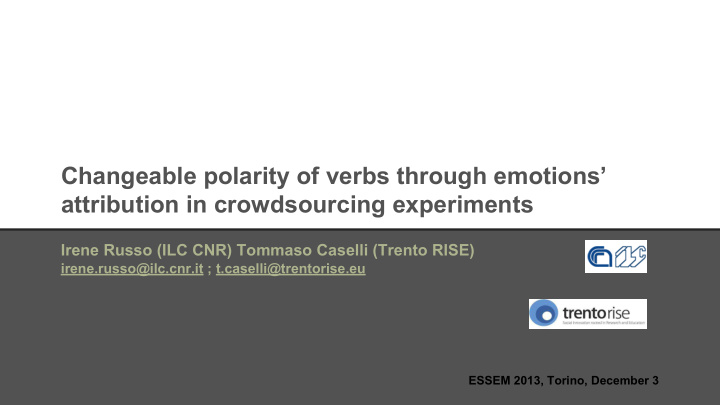



Changeable polarity of verbs through emotions’ attribution in crowdsourcing experiments Irene Russo (ILC CNR) Tommaso Caselli (Trento RISE) irene.russo@ilc.cnr.it ; t.caselli@trentorise.eu ESSEM 2013, Torino, December 3
Author and Reader Standing Point We can look at an opinion from two perspectives, i.e., the author (opinion holder) who expresses the opinion, and the reader who reads the opinion. For example, one wrote “The housing price has gone down, which is bad for the economy.” Clearly, this author talks about the negative impact of the dropping housing price on the economy. However, this sentence can be perceived in both ways by readers. For sellers, this is indeed negative, but for buyers, this could well be a piece of good news. [...] In current research or applications, researchers either ignore the issue or assume a standing point in their analysis. Usually, the opinion holders are assumed to be the consumers or the general public unless otherwise stated. (Liu 2012)
SA as a matter of perspective 1 Obama attacks Snowden. Reader’s stance is influenced by his/her awareness of the feelings and emotions of the agent and the patient associated with the event denoted by to attack . Through three crowdsourcing experiments, we test if there is agreement on the emotion attribution to the agent and to the patient in sentences such as “x VERB y”. Sentences with the target verb as the main predicate are related to 6 basic emotions (love, joy, surprise, anger, sadness and fear), following Parrott’s (2001) framework.
Crowdsourcing the emotion Three different crowdsourcing tasks (CrowdFlower platform): ● in the first task judgments on the emotion(s) of the grammatical subject (Agent or Experiencer); ● in the second tasks the emotion(s) of Patient; ● the third task tries to identify the emotion(s) of the reader/hearer of the reported situation. X [Human] hugs Y [Human] Emotion of X: love Emotion of Y: pleasure Emotion of EO: joy where X stands for the subject, Y for the patient and EO for the reader of the sentence
Agreement?
Polarity values
Conclusions We want to propose multiple values which could be activated in the reader/hearer mind. The main reason for this choice is linked to the working hypothesis that the participants of events can trigger different, even opposed, connotational polarity values and that the polarity value of the whole sentence is dependent on the empathic involvement of the reader/hearer. Future work will concentrate on the elaboration of specific rules to map a set of optional polarized values that can be accepted or refused also depending on the textual genre considered (i.e. social media vs. newspapers).
Recommend
More recommend